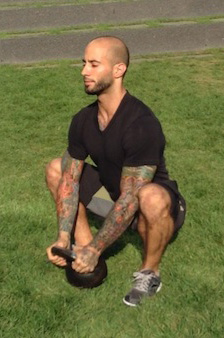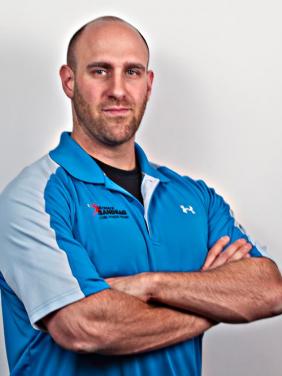If you have been exposed to the strength training systems of the RKC, then one could assume that you are no stranger to the benefits of squatting. The exercise enthusiast may look at the squat as an important movement utilized on a daily basis, but more commonly as an exercise made famous by its ability to cultivate copious levels of strength for the practitioner willing to put in the grueling work.
What happens when we no longer are able to access the full range of motion of such a fundamental pattern? It’s easy to give up on the lift—excusing age, bad knees or tight hips—and prioritize more of our time training the deadlift, but it has been noted by both Ido Portal and Gray Cook that the bottom position of the squat was formerly considered a position of rest and stability.
Shouldn’t we all make the effort to restore and maintain a movement that is so basic and primitive? The good news is that a little twist on a familiar drill can re-open the door to possibility and help take back the promised lands!
One of the most fundamental movements taught under the curriculum of the HKC is the Goblet Squat. To me this exercise is highly overlooked and its effects are easily understated. Though this is not a lift that will build slabs of flesh that hang off of your knee caps, it is a requisite lift that will teach your body how to properly balance, engage and stabilize throughout the start and completion of the movement creating greater potential for awesomeness down the road.
As is the case with many things that are good for us, there is a way to add to the Goblet Squat making it just that much more amazing!
First let’s look at the HKC standard for the Goblet Squat:
1. The back must remain neutral through the entire rep.
2. Your knees track your toes.
3. Your heels and toes should be planted.
4. Make sure to inhale down and exhale on the way up.
5. Your hips and shoulders must ascend at the same time.
6. Your hips and knees should extend fully at the top of the exercise.
Now let’s put this into application and teach you how to “feel” the movement.
Position yourself slightly behind a light kettlebell with heels shoulder width apart and toes slightly turned out. To find your start position, pull yourself down into the bottom position of a squat where the top surface of your upper thigh by the hip crease is lower than the top of the knee. If mobility is a known issue then sit low enough where the hips begin to slightly tuck under, but not low enough to lose a natural lumbar curve. Focus on keeping a neutral spine with an emphasis on lumbar lengthening. You should be able to feel your hamstrings and outer hips fire and begin to heat up. Avoid collapsing at the hips and resting on our heels with a rounded back at all costs.
Now that we have established the proper start position, reach your hands forward to grab the horns (outside handles), of the kettlebell pinning your elbows to the insides of your knees. Be sure that the boney part of your elbow touches the soft part of your knee, not to be confused with the softer inner thigh muscles. Still emphasizing your long spine, perform a double bicep curl bringing the center of the KB handle to your collarbone while simultaneously using your elbows to drive your knees apart. This “prying” effect will help loosen up tight adductor (groin) muscles that inhibit the outer hips from activating.
Now to teach your legs how to stabilize the squat by actively driving your knees away from your elbows, to create roughly 1-2 inches of separation between elbows and knees. Pause here to feel your deep outer hips activate, and then finally stand up to a complete lockout, raising your hips and shoulders together.
In order to finish the lift, actively tighten your hip flexors and hamstrings to pull your hips back to the bottom position of the squat. Just like the ascent, be sure to drive your knees apart while you reach the top of your hamstrings to the back of your heels.
Once you return to the bottom of the squat, place your elbows back against the soft part of your inner knee and re-extend your arms reaching the kettlebell down to a hover off of the floor. This will pry your knees apart again and set you up for the next rep. Be sure to keep the hips active and counter any forward lean by lifting your chest.
This drill is extremely beneficial when practiced before a squat session to help dial in the movement pattern and engage the posterior chain. Utilizing a small rep range of 1-2 sets of 6-8 reps will be enough to warm up the outer hips and legs in preparation to tackle a more rewarding set of double kettlebell front squats or high bar back squats.
Give this drill a go and keep me posted on how it affects your deep squat mobility and stability under heavier loads.
***
About Angelo Gala, RKC and PCC Team Leader: Angelo Gala has been a fitness professional in the Boston area for greater than 11 years. He is a Certified Strength and Conditioning Specialist through the NCSA, has studied the Pranavayu system of yoga under David Magone and he is a Dharma friend at the Sakya Center of Buddhist Studies in Cambridge, MA where he completed a 1 year intensive study of Mangalam Yantra Yoga Under the guidance of Lama Migmar Tseten. He can be reached through email.
He considers himself an all-around fitness nerd and endurance junkie who refuses to fall under the category of a one-trick pony. Gala continually works to better himself and inspire others by leading a lifestyle conducive to physical, emotional, and spiritual development. He believes that no one should focus too much time and energy on a single dimension of fitness. The body craves all different types of movement that is not limited to just running, jumping, swimming, biking or lifting things up and putting them down again and again. He teaches clients to train with intention progressively, intelligently and with as many different modalities as the heart desires. Do this and the body and mind will be forever grateful.












